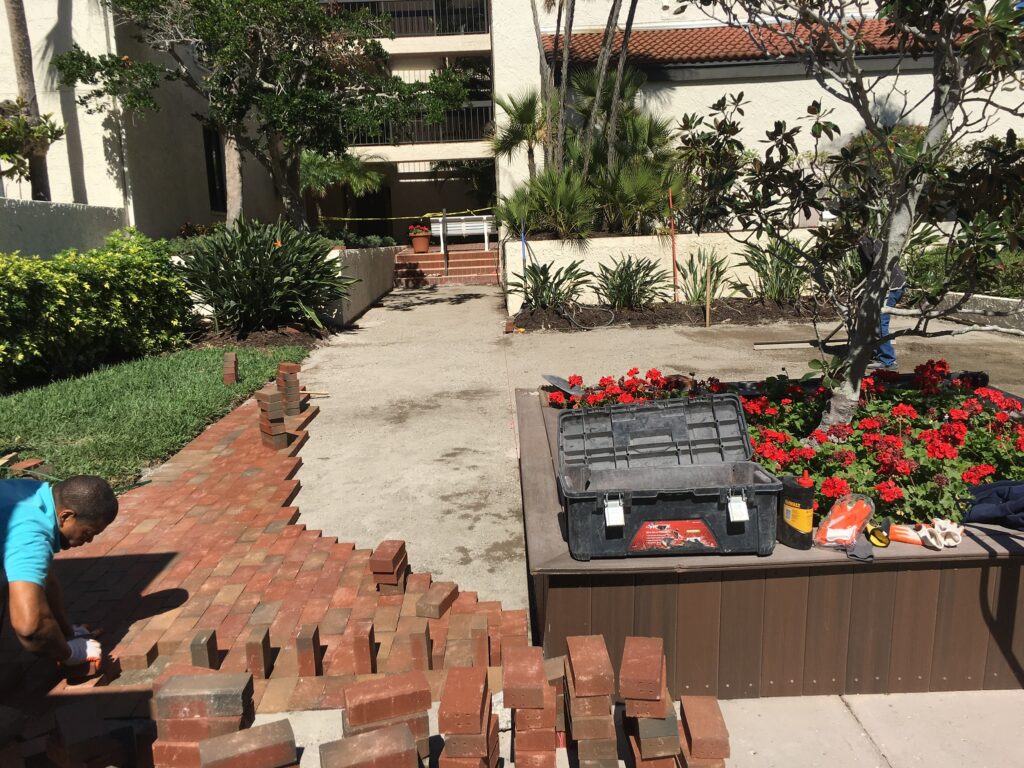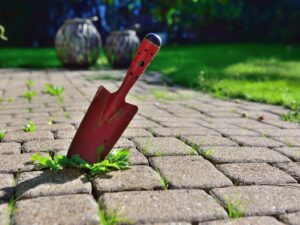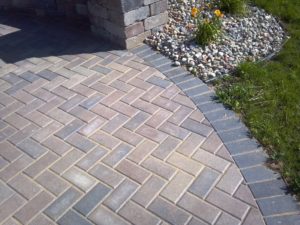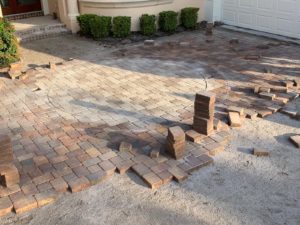Do you have a concrete patio or walkway and want to upgrade them with pavers? That’s really common. Pavers are well-known for their cost-benefit, especially when compared with concrete. But is it possible and how to lay pavers over concrete?
Pavers are not only known for their cost-benefit but also beauty and style. Installing pavers can significantly increase your home value and curb appeal.
Do you want to upgrade your patio, but have no idea how to lay pavers over concrete? Check this article to see everything you need to know about the installation process and how to do it.
How to Lay Pavers Over Concrete?
When installing pavers over concrete, you can use three installation options: sand set, mortar set, or bituminous set.
Sand Set
This is the most common method of laying pavers over a concrete base, especially with pedestrian applications, such as walkways and patios. It can be also applied in driveways as long durable bedding sand is used.
The process of laying pavers over concrete is the same as laying a paver patio over the ground. Pavers can be installed on top of concrete without mortar if you put a layer of sand between ½ to 1 inch first.
To install pavers over concrete using a sand set application it is recommended to follow the next steps:
- Step 1: Place a level of 1-inch sand bedding layer between the pavers and underlying concrete, this process is very similar to a standard paver installation.
- Step 2: Place holes at low spots, that will allow the water that seeps into the joints to escape.
- Step 3: Place your pavers following the directions provided.
Mortar Set
Using mortar to install pavers is also a really common method, but it’s important to say that a mortar set is not recommended when laying pavers over asphalt, because the asphalt is too flexible and can crack the mortar.
Follow the next steps to install pavers over concrete using a mortar set application:
- Step 1: Clean the concrete surface of all dirt, oil, and debris with a pressure washer and let it dry.
- Step 2: Place ½ inch of latex modified mortar underneath each paver, adhering it to the concrete. To ensure that the mortar stays wet for the application, you can work in smalls areas little by little.
- Step 3: Place the same latex modified mortar into the joints around each paver.
- Step 4: After the mortar dries, use a brush or striking tool to remove the mortar in excess.
Bituminous Set
The installation with bituminous is not very common. It is used only for high impact and friction areas.
Follow the next two steps when installing pavers over concrete using a bituminous set:
- Step 1: Place a level 1 inch bedding layer of sand mixed with a bituminous binder between the pavers and underlying the surface.
- Step 2: Ensure draining holes are placed in low spots, just like the sand set application, that allows water that seeps into the joints.
- Step 3: Place your pavers following the directions provided.

What to Consider Before You Lay Pavers Over Concrete?
Water Drainage
One of the biggest problems is when you lay pavers over concrete is the inability for the water to drain through the pavers.
It’s important to keep this drainage slope in mind when adding your pavers. For that, before the installation, make sure your concrete surface is properly sloped so the water doesn’t puddle. To help any puddling water seep into the ground, you can drill small drainage holes through the concrete.
Edging
To keep the sand and pavers from settling and squishing around, a concrete slab paver patio needs to be firmly edged. However, your edging needs to allow for water to properly drain. Otherwise, if it’s watertight, your patio could turn into a puddle.
Height
Your new patio or walkway needs to be up to 3 inches higher than the original concrete. You need to be sure to plan for transitions to other areas, especially if the patio adjoins your house.
Concrete Condition
If the concrete is in the right conditions, it’s possible to lay pavers over concrete to simplify the project and reduce costs. Otherwise, if the concrete surface is broken, very uneven, or in terrible conditions, the best option is ripping it off and start over with pavers.
What About a Free Estimate?
Do you want to upgrade your patio and lay pavers over concrete, but have no idea how much is gonna cost? What about a free estimate? If you live in Sarasota, Manatee, or any of our surrounding counties contact us, we will be glad to assist you!
S&S Pavers has over 10 years of experience serving the counties of Manatee and Sarasota.
FAQ
Can you lay paver on top of concrete?
Yes, and it is a very common practice. A thin variation of pavers are used for that purpose, usually accompanied by a mortar setting. However, as long as drainage is optimal, it is possible to also use them with a sand setting.
Are pavers cheaper than concrete?
Depends on if we are talking long term or short term. Short term, concrete is cheaper. But on the long run, pavers can last much more and present way less maintenance problems, so they are worth the initial upfront cost.
Do I need to seal my pavers?
Yes. Sealing is a must if you’re working with porous pavers. It protects them against the weather and helps in the prevention of weeds.
Do pavers last longer than concrete?
Yes, much more. Concrete can last at most 25 years, losing its optimal function after 10 years or so. Pavers, however, as long as properly maintained, can last up to 50 years without losing their quality or function.




